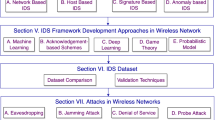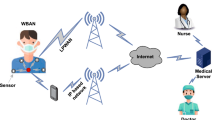Abstract
In this paper, a proposed new wireless protocol so-called wireless controller area network is introduced. WCAN is an adaptation of its wired cousin, controller area network protocol. The proposed WCAN uses token frame scheme in providing channel access to nodes in the system. This token frame method follows the example used in wireless token ring protocol which is a wireless network protocol that reduces the number of retransmissions as a result of collisions. This scheme based on CAN protocol allows nodes to share a common broadcast channel by taking turns in transmitting upon receiving the token frame that circulates around the network for a specified amount of time. The token frame allows nodes to access the network one at a time, giving ‘fair’ chance to all nodes instead of competing against one another. This method provides high throughput in a bounded latency environment. The proposed WCAN protocol has been developed and simulated by means of QualNet simulator. The performances of this proposed protocol are evaluated from the perspective of throughput, end-to-end delay and packet delivery ratio, and are compared against the IEEE 802.11 protocol. Simulation results show that the proposed WCAN outperforms IEEE 802.11 based protocol by 62.5 % in terms of throughput with increasing network size. Also, it shows an improvement of 6 % compared to IEEE 802.11 standard at a higher data interval rate.



























Similar content being viewed by others
References
Controller Area Network (CAN) Overview—Tutorial, National Instruments Developer Zone, (2011). http://www.ni.com/white-paper/2732/en
Ng, W. L., Ng, C. K., Ali, B. M., Noordin, N. K., & Rokhani, F. Z. (2010). Wireless controller area network with token ring scheme. In Conference on electrical and electronic technology, 4th world, engineering congress(WEC 2010) pp. 593–600.
BenGouissem, B., & Dridi, S. (2006). Data centric communication using the wireless control area networks. In IEEE international conference on industrial technology ( ICIT 2006), pp. 1654–1658.
Kutlu, A., Ekiz, H., & Powner, E. T. (1996). Performance analysis of MAC protocols for wireless control area network. In Second international symposium on parallel architectures, algorithms, and networks, pp. 494–499.
Hasegawa, G., & Murata, M. (2010). Trade-off evaluation between fairness and throughput for TCP congestion control mechanisms in a wireless LAN environment. In International symposium on performance evaluation of computer and telecommunication systems (SPECTS 2010), pp. 22–29.
Singh, J. P., Bambos, N., Srinivasan, B., & Clawin, D. (2002). Wireless LAN performance under varied stress conditions in vehicular traffic scenarios. In IEEE 56th vehicular technology conference (VTC 2002-Fall), vol. 2, pp. 743–747.
Ergen, M., Lee, D., Sengupta, R., & Varaiya, P. (2004). WTRP—wireless token ring protocol. IEEE Transactions on Vehicular Technology, 53(6), 1863–1881.
Pazul, K. (1999). Controller area network (CAN) basics. USA: Microchip Technology Inc.
Davis, R. I., & Burns, A. (2009). Robust priority assignment for messages on controller area network (CAN), real-time systems. Springer Science and Business Media, 41(2), 152–180.
Barranco, M., Proenza, J., & Almeida, L. (2009). Boosting the robustness of controller area networks: CANcentrate and ReCANcentrate. Computer, 42(5), 66–73.
Alheraish, A. (2004). Design and implementation of home automation system. IEEE Transactions on Consumer Electronics, 50(4), 1087–1092.
Rodriguez-Navas, G., Roca, S., & Proenza, J. (2008). Orthogonal, fault-tolerant, and high-precision clock synchronization for the controller area network. IEEE Transactions on Industrial Informatics, 4(2), 92–101.
Corrigan, S. (2008). Introduction to the controller area network (CAN)., Application Report, Texas Instrument, http://www.ti.com/lit/an/sloa101a/sloa101a.pdf.
Kaushik, S. K., Chahal, K., Singh, S., & Dhariwal, S. (2012). Performance evaluation of mobile Ad hoc networks with reactive and proactive routing protocols and mobility models. International Journal of Computer Applications, 54(17), 28–35.
Setty, S. P., Raju, K. N., & Kumar, K. N. (2010). Performance evaluation of AODV in different environments. International Journal of Engineering Science and Technology, 2(7), 2976–2981.
Gao, Y., Luo, D., Zuo, D., & Yang, X. (2008). Research on routing protocol of wireless Ad hoc network based on wearable computers. International Symposium on Computer Science and Computational Technology (ISCSCT ’08), 1, 491–494.
RamMurthy, G., Reddy, G. N., & Varma, A. R. S. (2011). Modified distributed laxity based priority scheduling scheme. Wireless Personal Communications, 58, 627–636.
Al-Karaki, J. N., & Kamal, A. E. (2008). Stimulating node cooperation in mobile Ad hoc networks. Wireless Personal Communications, 44, 219–239.
Akyildiz, I. F., & Wang, X. (2005). A survey on wireless mesh networks. IEEE Communications Magazine, 43(9), S23–S30.
Sichitiu, M. L. (2005). Wireless mesh networks: Opportunities and challenges. : In Wireless World Congress.
Author information
Authors and Affiliations
Corresponding author
Rights and permissions
About this article
Cite this article
Ng, W.L., Ng, C.K., Ali, B.M. et al. Performance Evaluation of Wireless Controller Area Network (WCAN) Using Token Frame Scheme. Wireless Pers Commun 72, 1847–1873 (2013). https://doi.org/10.1007/s11277-013-1099-7
Published:
Issue Date:
DOI: https://doi.org/10.1007/s11277-013-1099-7




